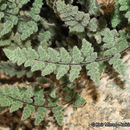en
names in breadcrumbs


Cheilanthes, commonly known as lip ferns,[2] is a genus of about 180 species of rock-dwelling ferns with a cosmopolitan distribution in warm, dry, rocky regions, often growing in small crevices high up on cliffs. Most are small, sturdy and evergreen. The leaves, often densely covered in trichomes, spring directly from the rootstocks. Many of them are desert ferns, curling up during dry times and reviving with the coming of moisture. At the ends of veins sporangia, or spore-bearing structures, are protected by leaf margins, which curl over them.
The genus name is derived from the Greek words χεῖλος (cheilos), meaning "lip," and ἄνθος (anthos), meaning "flower."[3]
Cheilanthes as traditionally circumscribed is now known to be highly paraphyletic, comprising at least four generically separate groups. The type species, C. micropteris, is most closely allied to the genera Aleuritopteris and Sinopteris (Schuettpelz et al.). In the early 21st century, many species, principally from the New World, were moved into the new genus Gaga and the revived genus Myriopteris. Further work remains to be done to render Cheilanthes monophyletic. Members of many other cheilanthoid genera have at times been given names in the genus.
The circumscription of the genus was uncertain as of January 2020. The Checklist of Ferns and Lycophytes of the World lists species in several distinct groups.[4]
Cheilanthes sensu stricto contains about 20 species from North and tropical Central and South America:[5]
Cheilanthes sensu lato contains about 50 species that molecular phylogenetic studies suggest do not form a clade with the core Cheilanthes species, falling into separate clades, but for which no placement outside Cheilanthes was available as of November 2019:[6]
Cheilanthes, commonly known as lip ferns, is a genus of about 180 species of rock-dwelling ferns with a cosmopolitan distribution in warm, dry, rocky regions, often growing in small crevices high up on cliffs. Most are small, sturdy and evergreen. The leaves, often densely covered in trichomes, spring directly from the rootstocks. Many of them are desert ferns, curling up during dry times and reviving with the coming of moisture. At the ends of veins sporangia, or spore-bearing structures, are protected by leaf margins, which curl over them.